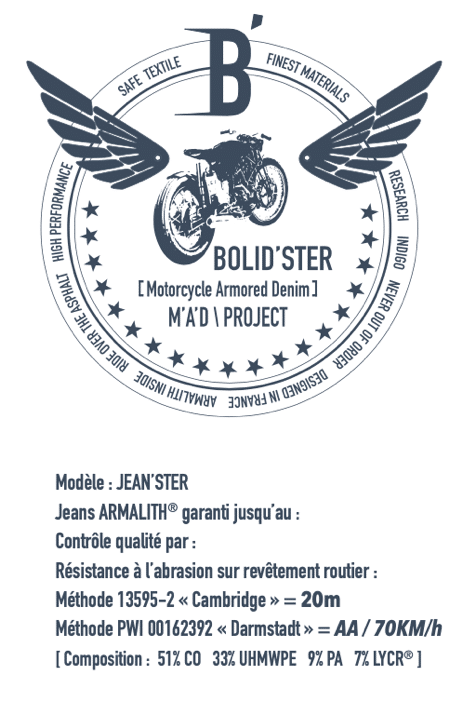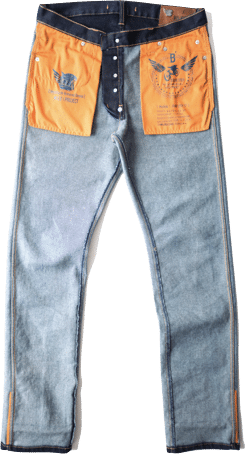Abrasion resistance
BOLID’STER jeans are all cut from ARMALITH®. But there are several levels of abrasion resistance and a whole family of ARMALITH® fabrics. ALL BOLID’STER jeans are tested according to the 2 official methods for abrasion in motorcycle conditions (Cambridge and Darmstadt).
The test results are written directly inside our jeans.

Classic jeans do not provide any protection against abrasion. At the moment of impact on the road surface, the fabric gives way, leaving the skin to “manage” the rest of the slide.

Thick “raw” jeans, like Levis 501 from the 80s, are a bit more resistant, but inconsistently.
- We think it’s reckless to ride a motorcycle with so little protection.
Jeans cut in ARMALITH® XLight resist more than 10m in the Cambridge test, which corresponds to a simulated fall at 45KM/h according to the Darmstadt standard.
- We recommend this level for urban riding (Urban), biking, skateboarding, electric scooters or even your Ducati, but you should never exceed 45Km/h.
Jeans made of ARMALITH® Light can withstand more than 14m in the Cambridge test, which corresponds to a simulated fall at 70KM/h according to the Darmstadt standard.
Jeans cut in ARMALITH® Regular (i.e. ARMALITH® Long stretch and ARMALITH® Skin) withstand more than 20m in the Cambridge test which corresponds to a simulated fall at 70KM/h according to the Darmstadt standard.
- We recommend these levels of protection to provide peace of mind when riding a motorcycle ( a cruiser). The protection provided corresponds to that of a leather of 400Gr/ m2.
The jeans cut in ARMALITH® Power resist more than 32m in the Cambridge test which corresponds to a simulated fall at 70KM/h according to the Darmstadt standard.
- The protection provided corresponds to that of a 600Gr/ m2 leather. Do not forget to respect the speed limits and also remember that abrasion protection is not sufficient if you fall.

As you can see from the examples above, the Darmstadt and Cambridge standards do not always correspond to each other. Because of these differences, we decided to conduct both tests systematically, since they are complementary in any case.
The Cambridge standard is the historical regulatory basis for motorcycle and karting competitions on the circuit, with very high resistance values (about 56m) and materials limited to leather! This standard was then expanded to measure the resistance of professional clothing worn police forces, customs officers etc (About 32m).
Then there was a demand for an urban-type resistance measurement (between 10m and 20m) but the machine and the test protocol turned out to be unreliable for this.
This is how the Darmstadt standard increased in popularity, because it is better adapted to low abrasion resistance measurements, it “expands” the measurement scale and gives precise information for resistance ranges from 10m to 32m.
Abrasion protection is essential in motorcycle equipment and above all its effectiveness is superior to impact protection.
So measuring abrasion resistance is super important and BOLID’STER aimed to remove the ambiguities surrounding this issue.
We hope that this information will help you to have a more precise idea and will allow you to choose your equipment according to your use, with full knowledge of the facts.